
(A near-perfect ChurchCrawl - March 21st 2002)
I left Bristol on a grey day, with low cloud. The weather forecast suggested that it would at least stay dry with the prospect of some sunny periods in the afternoon. My week's holiday was rapidly running out and I had been nowhere! My first plan came to nothing, and so I decided to head across the foggy Severn Estuary to Wales. I crossed with the old Severn Bridge, and ignoring Chepstow took the A466 "Wye Valley" road towards Monmouth.
ST ARVANS St Arvan
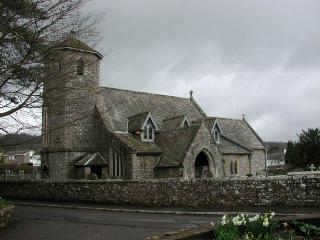 |
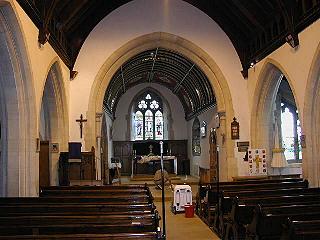 |
Just north of Chepstow, and Chepstow Racecourse, is the small village of St Arvans. Stay on the main road and you will miss most of it, including the church. The church is situated in a quiet area away from the through-roads and has a picturesque appearance thanks mainly to the octagonal west tower of c1830s and John Prichard's heavy restoration of 1883-4 which was almost a rebuilding. Three dormer windows on each side of the nave roof light up the aisles inside. In fact the only ancient part is the south wall of the chancel with a tall early Norman priest's door and a paired lancet window to the east. One of the imposts of the doorway is carved with an intricate pattern of boxes filled by crosses with blobs in the spaces, the other is plain.
My visit coincided with that of the carpet cleaner (on his knees in the picture above) who was busy ironing brown paper over the myriad of candle wax droppings. They would have kept him here the whole day for sure! An older resident is the worn and headless red sandstone effigy on the sill of the west window of the south aisle. It is uncertain whether this is a lady or a civilian. The church is well-cared for and has had further improvements in recent times, including two modern abstract stained-glass windows in the north aisle (by Alan Younger) and the painting of the chancel's wagon roof. (Usually open)
PENTERRY St Mary
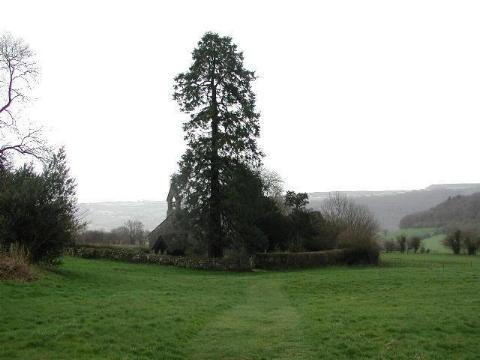
Taking a minor road from St Arvan's, passing a turning to Penterry Farm, look out for a gate on the right marked Penterry Church. The church is only reachable by walking downhill through the field from the road, with beyond the steep slopes of the Wye Valley. The church is a small simple rectangle of considerable date - see the Norman window on the north side of the sanctuary, and the C15 two-light square-headed east window. Otherwise the church shows only details from Prichard & Seddon's restoration of 1853-61. They moved the south doorway to the west, and gave it an open sided porch. Their's too the large west bellcote. Still no matter as it is the setting of this church which inspires you, and the fact that the church was locked was a disappointment rather than the so-often remaining final impression.
CHAPEL HILL (Tintern) St Mary
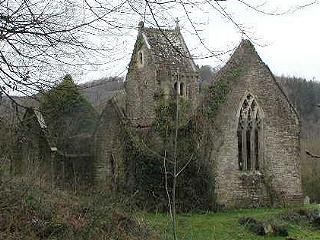 |
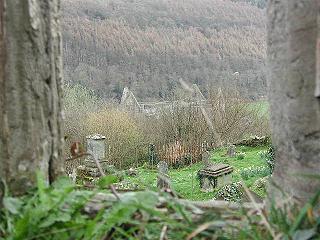 |
The road from Penterry is not for the feint-hearted, as you drop through the wooded sides of the Wye Valley. Chapel Hill (or Llanandras in Welsh) is the village that lies above the famous ruins of Tintern Abbey, and you can glimpse the tower from Cadw's manacured lawned ruins. A steep cobbled (and rather dangerous when wet) path leads up to the churchyard. The church is medieval in origin and may incorporate some Decorated features, but the whole was virtually rebuilt by John Prichard 1866-8. It has a nave and chancel in one, a north saddleback tower and vestry and burial vault on the south side. There was a serious fire in the 1970s and the decision was taken to remove the roof thereafter. Some artefacts were transferred to Tintern Parva church. It is now a pretty ruin, slowly being swallowed by ivy. Inside amongst the vegetation are remains of floor tiles, a shattered font and a rather pretty piscina. The view of the abbey from the east window of cours (above) was never intended. (Ruins accessible at any time)
TINTERN PARVA St Michael
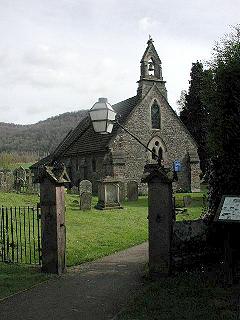 |
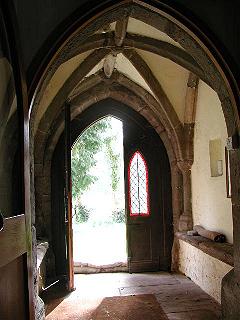 |
From the Abbey / Chapel Hill area the village of Tintern Parva spreads itself around a large curve in the river. At the northern end lies the church of St Michael, close to the banks of the tidal Wye. Indeed so close as to have sandbags at the south porch entrance (above)! The low cloud of the morning was now breaking up and the sun was quite warm. This small church was largely rebuilt in the 1840s and gone over again in 1889. However the C15 south porch itself has survived and is surprisingly vaulted. Inside on the north wall is the former reredos from Chapel Hill, a medieval font and a wall memorial to Julia Roberts d1839 which has a relief of a deathbed scene (signed by Woolcot of Bristol). (Open)
LLANDOGO St Oedoceus
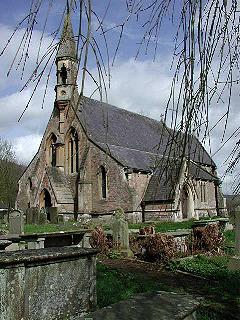 |
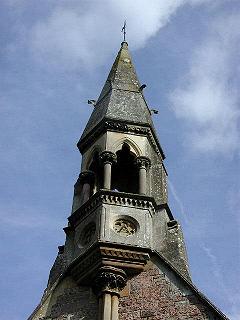 |
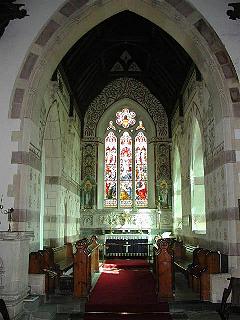 |
The next village reached on the main Chepstow-Monmouth road contains the best Victorian church in the area. It was built 1859-61 to the designs of J.P.Seddon (of Prichard & Seddon). It has some quirky features including having both a west and a south porch (when the village is to the north). The bellcote is described by John Newman (Buildings of Wales: Gwent, London 2000) as being like a "pulpit in the sky" and rests on a mid front buttress between a pair of two-light windows, which continues up as a shaft and capital to the base of the bellcote. Inside has banded stone in the arcades and walls, and the chancel was further embellished by decoration in 1889. The superb glass in the east window is by Hardman c1879 and the reredos below in white marble and alabaster incorporates doves, whatsheafs and vines. (If locked - key from the village stores on the main road to the NE)
WHITEBROOK Holy Trinity
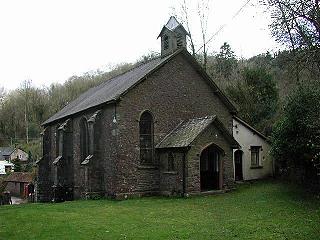 |
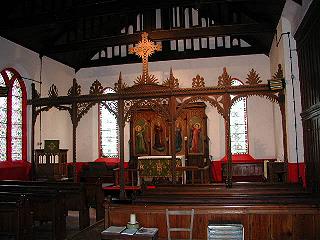 |
North of Llandogo the main road crosses the Wye into Gloucestershire and England. If you stay on the welsh side the next village you come to is the enchantingly sited village of Whitebrook on the small river of the same name, with steep wooded sides. From the C17 to late C19 however this was quite an industrial area and there are ruins or conversions of many mills and works throughout the valley. Still part of the parish of Llandogo, St James church was built by subscription in 1835. Fat east and west lancets and timber Y-traceried north windows. Domestic rooms and hall adjoins on the south side, screened off internally. The simple interior is divided into nave and chancel by a rather absurdly ornate screen of 1892, the detail almost indian in feel. (Open)
TRELLECH St Nicholas
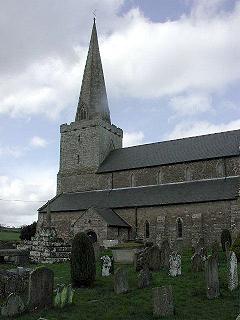 |
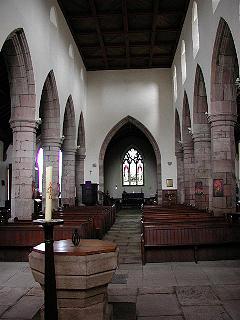 |
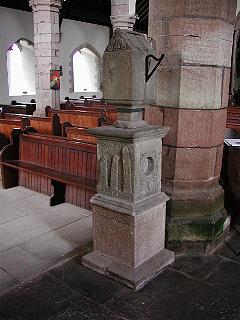 |
By far the most important and largest church in the area. I have visited before and been impressed, but today was not the day for large and dominant buildings, and in hindsight I wish I had not stopped. The churchyard wall was also being rebuilt, temporary traffic lights and workmen abounded outside and parking was difficult apart from the pub car-park! All rather uniform in design and superbly cared for. It is probably early C14, and the Victorian restorer here was E.H.Lingen Barker1893-4. He redid the roofs, gave the chancel a new window and re-opened two aisle windows but all-in-all quite restrained! Note how the aisles are continued west to embrace the tower. Inside tall five-bayed arcades and a number of interesting artefacts. Under the tower are a number of stone relics, incides slabs and what appears to be a former font bowl, together with a brightly coloure carved Royal Arms of Charles II. In the sanctuary Laudian three-sided altar rails with twisted balusters. The pulpit is of a similar date. Towards the west end of the south aisle is a time-piece that can work no longer in this position, a carved sundial of 1689. (Open)
LLANFIHANGEL-TOR-Y-MYNYDD St Michael
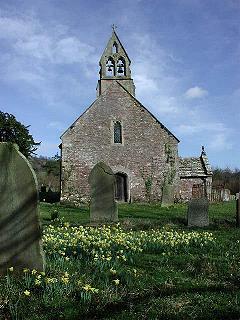 |
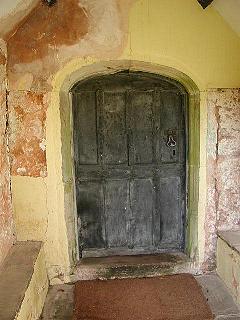 |
This was the only bit of the day that really annoyed me. A huge brown tourist sign points to this church from the main Trellech-Devauden road, another points you down a track, a third points you towards a car-parking area. The setting is delightful for this small medieval church, and the churchyard was full of daffodils. The sun was warm on my back, I approached the ancient south door in the porch and it was locked! How can this be? I asked at the neighbouring house and the lady there commented that people were always asking her where the key could be obtained and she did not know. I had not planned to visit here today but I was seduced by the tourist road sign. At the very least there could be a sign pointing out where the key was to be had, but really after all the effort in getting here it is extremely rude to find access is denied.
DEVAUDEN St James
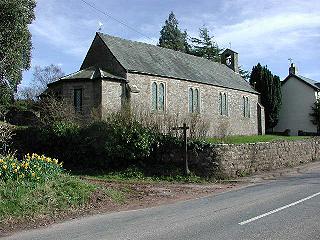
The church in Devauden was built as a school in 1815, but must have become the church soon after as the apse was added in 1838. As I was running late I did not try and track down the key to the church but the exterior suggests that there is not much to detain the visitor for very long. (Locked)
KILGWRRWG Holy Cross
There are some places that will remain special and this is one of them. It is perhaps the remotest church in Wales if not in the whole of Great Britain. It is remarkable that it still survives, let alone is still in regular use, given that you can only get to it by crossing two fields and a stream from the nearest house.
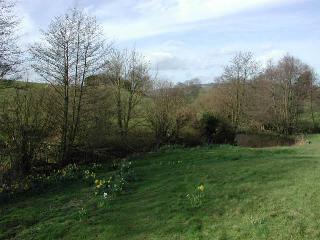 |
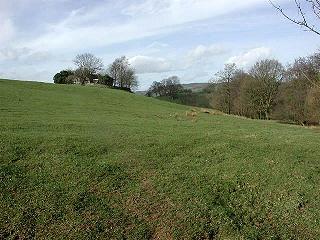 |
Having left the farm behind you head towards the church placed on the edge of the hillside in the distance, surrounded by trees. The owner has planted daffodils close to the footbridge seen to the left of the left-hand photo above. Crossing into the next field the climb upwards begins. I was very lucky with the weather although I did disturb the sleeping lambs in the field.
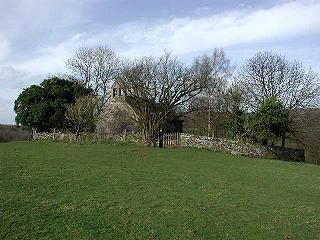 |
Almost there, and the building can be appreciated for the first time, and the circular churchyard can be noted, a mark of great antiquity as a religious site. A small gate keeps you on track!
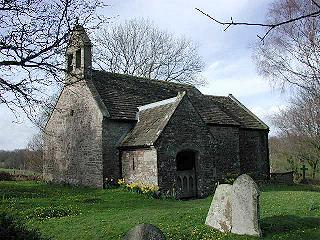 |
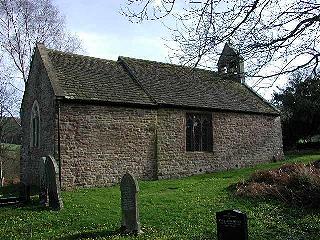 |
Opening the gate and stepping into the churchyard, the compactness of the church can be compared with some of the other buildings visited today. Daffodils abound near the church porch, a porch which is almost as big as the chancel beyond. There are equally few windows, one in the north wall, one in the south wall and a small east window. There is no west window, but here is set an amusing corbel carved with a face, high above the blocked west doorway. No tower but a double bellcote rides the west gable. The porch and bellcote belong to Prichard's restoration of 1871 yet they seem to belong. Prichard provided the east window and copied the C15 south window in making the north window.
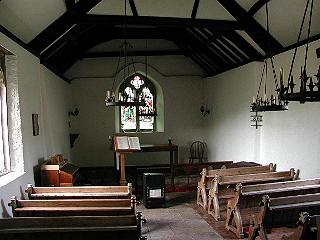 |
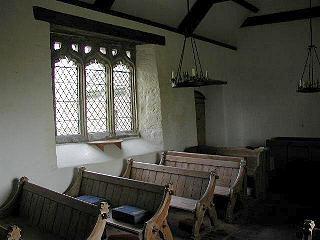 |
The interior is simple, and there is no chancel arch, just a roof truss. Candles sit in the chandeliers, as there is no electricity or water into this remote place. The glass in the east window is of c1920 and depicts the allegorical figures of Peace (l) and Victory (r) and was made by R.J.Newbery. You can picture it being carried towards the church at the end of the first world war. Amazingly another restoration was completed 1989-90 at a cost of GBP37,000, which should ensure its survival for generations to come.
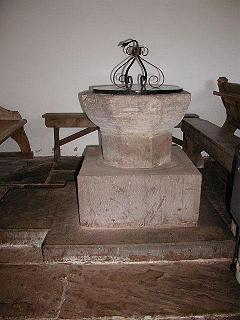 |
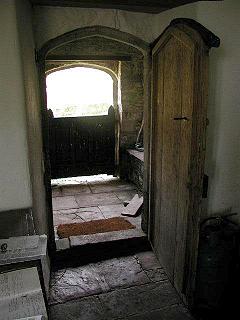 |
The plain font appears larger in this setting. It is the only stone feature of the interior. The other fittings are simple and wooden. So the door is open once more and it is time to leave this place. It seems rather corny, but the whole church gives meaning to the phrase "Peace on Earth", whatever your religion or beliefs.
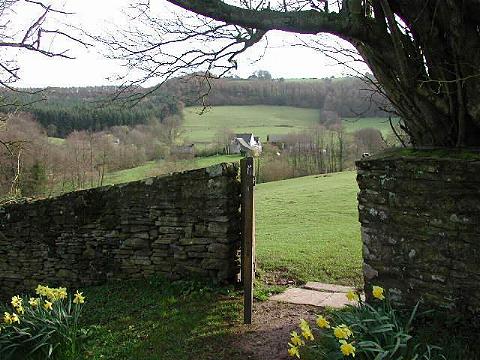
Now back through the gate (I didn't forget to close it!) and back down through the fields to the farmhouse in the distance. My car was parked here, by kind permission of the owner, as the road to the farm is really a private one. The modern village of Kilgwrrwg lies up on the hilltop beyond the trees on the left, where the public highway ends. (Open)
ITTON St Deiniol
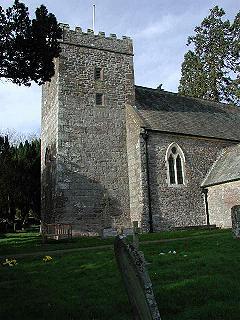 |
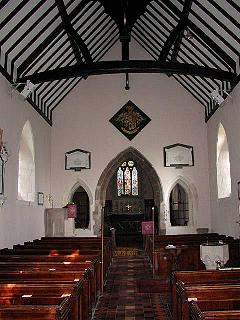 |
Following the enchanting visit to Kilgwrrwg, I almost didn't stop here at Itton. It is unfortunately placed for me, I always seem to drive by the turning at the end of a day out. So as the weather was still good I headed towards the church which stands away from its village between Itton Court and their stables. It was locked but a key was available nearby. The tower and the chancel arch are probably C14, as is much of the south porch. The rest was over-restored by Henry Woodyer in 1869. By him the masterstroke of the interior, creating two flanking openings by the chancel arch. Most of the fittings belong to the restoration too, or are later still. Some pretty wall memorials but none especialy good.
So my day ended here in the sunshine at Itton. I will never forget the walks to Penterry and Kilgwrrwg, the peace and calm at Kilgwrrwg, the Victorian work at St Arvans and Llandogo, and the clumps of golden daffodils almost every where. I hope I have conveyed a little something of why this ChurchCrawl was near-perfect.